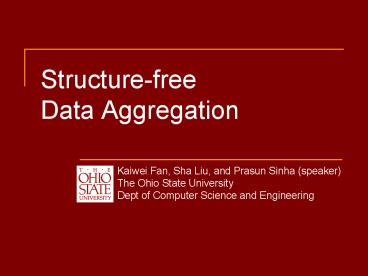Structurefree Data Aggregation - PowerPoint PPT Presentation
1 / 22
Title:
Structurefree Data Aggregation
Description:
Data Aggregation. Kaiwei Fan, Sha Liu, and Prasun Sinha (speaker) The Ohio State University ... AT-2: Aggregation tree approach with varying delay. DAA RW ... – PowerPoint PPT presentation
Number of Views:61
Avg rating:3.0/5.0
Title: Structurefree Data Aggregation
1
Structure-freeData Aggregation
- Kaiwei Fan, Sha Liu, and Prasun Sinha
(speaker)The Ohio State UniversityDept of
Computer Science and Engineering
2
Outline
- Introduction
- Structure-free Data Aggregation
- Simulation Results
- Experiments on a testbed
- Conclusion
3
Introduction
- Data Aggregation
- In-network processing
- Reduces communication cost
- Approaches
- Static Structure
- LEACH, TWC 02
- PEGASIS, TPDS 02
- Dynamic Structure
- Directed Diffusion, Mobicom 00
- DCTC, Infocom 04
4
Static Structure
- Pros
- Low maintenance cost
- Good for unchanging traffic pattern
- Cons
- Unsuitable for event triggered network
- Long link-stretch
- Long delay
sink
5
Static Structure
- Pros
- Low maintenance cost
- Good for unchanging traffic pattern
- Cons
- Unsuitable for event triggered network
- Long link-stretch
- Long delay
sink
6
Dynamic Structure
- Pros
- Reduces communication cost
- Cons
- High maintenance overhead
sink
7
Structure-free Data Aggregation
- Challenge
- Routing who is the next hop?
- Waiting who should wait for whom?
- Approach
- Spatial Convergence
- Temporal Convergence
- Solution
- Data Aware Anycast
- Randomized Delay
Routing?
Waiting?
sink
8
Data Aware Anycast
- Improve Spatial Convergence
- Anycast
- One-to-Any forwarding scheme
- Anycast for Immediate Aggregation
- To neighbor nodes having packets for aggregation
- Keep Anycasting for Immediate Aggregation
sink
9
Data Aware Anycast
- 50 nodes in 200mx200m
sink
10
Data Aware Anycast
- Forward to Sink
- To neighbor nodes closer to the sink
- Using Anycast for possible Immediate Aggregation
sink
11
Data Aware Anycast
- Forwarding and CTS replying priority
- Class A Nodes for Immediate Aggregation
- Class B Nodes closer to the sink
- Class C Otherwise, do not reply
CTS slot
mini-slot
Class B
Class A
RTS
Sender
CTS
Class A Nbr
Canceled CTS
Class A Nbr
Canceled CTS
Class B Nbr
Class C Nbr
12
Randomized Waiting
- Improve Temporal Convergence
- Naive Waiting Approach
- Use delay based on proximity to sink (closer to
sink gt higher delay) - Long delay for nodes close to the sink in case
the event is near the sink - Our Approach Random Delay at Sources
13
Analysis
- Y Number of hops a packet is forwarded before
being aggregated - Assumptions
- Each node has k choices for next
- hops closer to sink
- All n nodes have packets to send
- EY
- x random delay in 0,1 picked up by a node
- dh random delay chosen by a node h hops away
from sink - Total Number of Transmissions
14
Analysis vs. Simulation
- Results matches up to 40 hops
- Gap increases as network size increases
- Reason transmission delay is ignored in analysis
15
Simulation Results
- Evaluated Protocols
- Opportunistic (OP)
- Optimum Aggregation Tree (AT)
- Data Aware Anycast (DAA)
- Randomized Waiting (RW)
- DAARW
- Evaluated Metric
- Normalized Number of Transmissions
- Parameters Studied
- Maximum Delay
- Event Size
- Aggregation Function
- Network Size
16
Simulation Results Maximum delay
- Configuration
- 33 x 33 grid network
- event moves at 10m/s
- event radius 200m
- 140 nodes triggered by the event
- data rate 0.2 pkt/s
- data payload 50 bytes
- AT-2 Aggregation tree approach with varying
delay - DAARW improve OP by 70
17
Simulation Results Maximum delay
- AT is sensitive to delay
- AT has best performance with highest delay
18
Simulation Results Event Size
- Configuration
- event radius 50m 300m
- 8 260 nodes triggered by the event
- event radius 200m
- Key Observations
- DAARW is much better than OP
- DAARW is close to AT (optimal tree)
19
Simulation Results Aggregation Ratio
- Configuration
- Aggregation Ratio ?0 1
- Packet sizemax(50, 50 (1-?) n)
- Max packet size400 bytes
- Key Observation
- DAARW performs better than AT
- Following the best tree is not optimum if the
packet size is limited
20
Simulation Results Network Size
- event distance to the sink 300m 700m
- event radius 200m
- Key Observation
- Improvement is higher for events farther from the
sink
21
Experiment Randomized Waiting
- Linear network with 5 sources and 1 sink
- 0.2 pkt/s
- data payload 29 bytes
- Key Observation
- Delay as low as 0.1 is sufficient for optimizing
performance
22
Conclusion
- Data Aware Anycast for Spatial Convergence
- Randomized Waiting for Temporal Convergence
- Efficient Aggregation without a Structure
- High Aggregation
- No maintenance overhead

